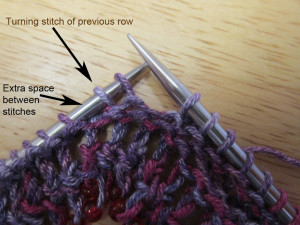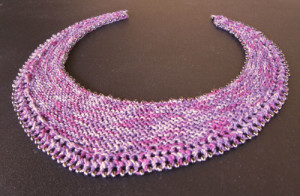Short rows are used to create the crescent shape of the Beaded Crescent Neck Lace. Think of Simple Short Rows as natural lacy holes.
The steps we have completed so far in knitting the Neck Lace are –
- Beaded Loops Edging (the lower edge around the Neck Lace in the above picture), and
- Casting on using the Beaded Loops Edging as a basis (the foundation for beginning the short row shaping)
Now we are ready to continue with short rows to create the crescent shape.
Quick Definition: A short row (or round) in knitting is worked for only part of the stitches in that row (round), leaving the remaining stitches unworked.
Short rows are often used in knitting to create curves, darts, etc. i.e. some sort of 2- or 3-dimensionality.
There are many methods of working short rows to give different effects or optimize different design features. For the Beaded Crescent Neck Lace, I chose what I call Garter Stitch Simple Short Rows. My basic (jogless) technique boils down to this:
- Knit to where the short row is supposed to end (the last stitch you knit is called the turning stitch)
- Turn the work to the other side
- Bring the yarn between the needles from front to back (the unworked stitches will be to the right and the stitches worked so far in short rows will be to the left)
- Slip the first stitch purlwise with yarn in back
- Continue knitting across row until you reach the turning stitch of the previous row, and then knit whatever number of stitches beyond that as called for in the design to create the crescent shape
Tip: Think of Simple Short Rows as natural lacy holes. For those of you familiar with other methods of short rows, there is no “wrap” in this simple short row method. Wraps are a strategy to avoid holes. Since we embrace holes in lace, the simple short row method can give a harmonious look in lace knitting.
Set Up Row
To set up for creating a symmetrical crescent, mark the center position of the row. Then knit to the center + an number of stitches (for the Beaded Crescent Neck Lace, the additional number of stitches = 4).
* Turn and knit to 4 stitches beyond the turning stitch of the previous row. Repeat from * until no more stitches remain at either end of the needles when you make the turn.
How to see or feel the turning stitch of the previous row
If necessary, you can use markers to help you identify your turning stitch. But I would encourage you to practice seeing or feeling where the turning stitch as it can eventually save you time in moving markers repeatedly.

There is a slight gap you can see or feel between the turning stitch of the previous row and the next unworked stitch
There is a slight gap you can see (or feel if your fingers are sensitive enough) between the turning stitch of the previous row and the next unworked stitch.
The Formula for Jogless Simple Short Rows
Slipping the first stitch after the turn graduates the height differential; i.e. eliminates the “jog” you sometimes see happen with other types of short row techniques where there is an immediate stair step effect of 2 rows.
- In garter stitch (such as in the Beaded Crescent Neck Lace), slip that first stitch purlwise with yarn in back.
- In stockinette stitch (such as in the newly published HeartStrings pattern Swags of Lace Crescent Scarf), on RS slip with yarn in back (wyib) on RS; on WS slip with yarn in front (wyif); i.e. same position of the yarn as when you are working stockinette stitch



 HeartStrings FiberArts
HeartStrings FiberArts Knitting Bits of Lace on Facebook
Knitting Bits of Lace on Facebook Ravelry Store
Ravelry Store
Pingback: Using the Beaded Loops Edging as a basis for casting on | Knit HeartStrings || BOBBOL 2013 Monthly KAL's
Jackie, I am helping several members make this lovely necklace. Your tutorials are so well done and we are most appreciative.
I noticed in the very last line in the “Formula for Jogless Simple Short Rows” above that you typed …WS slip with yarn in BACK (wyif). I think you mean it to be front.
If I’m wrong, please let me know.
Best!
Thanks. I corrected that right away.